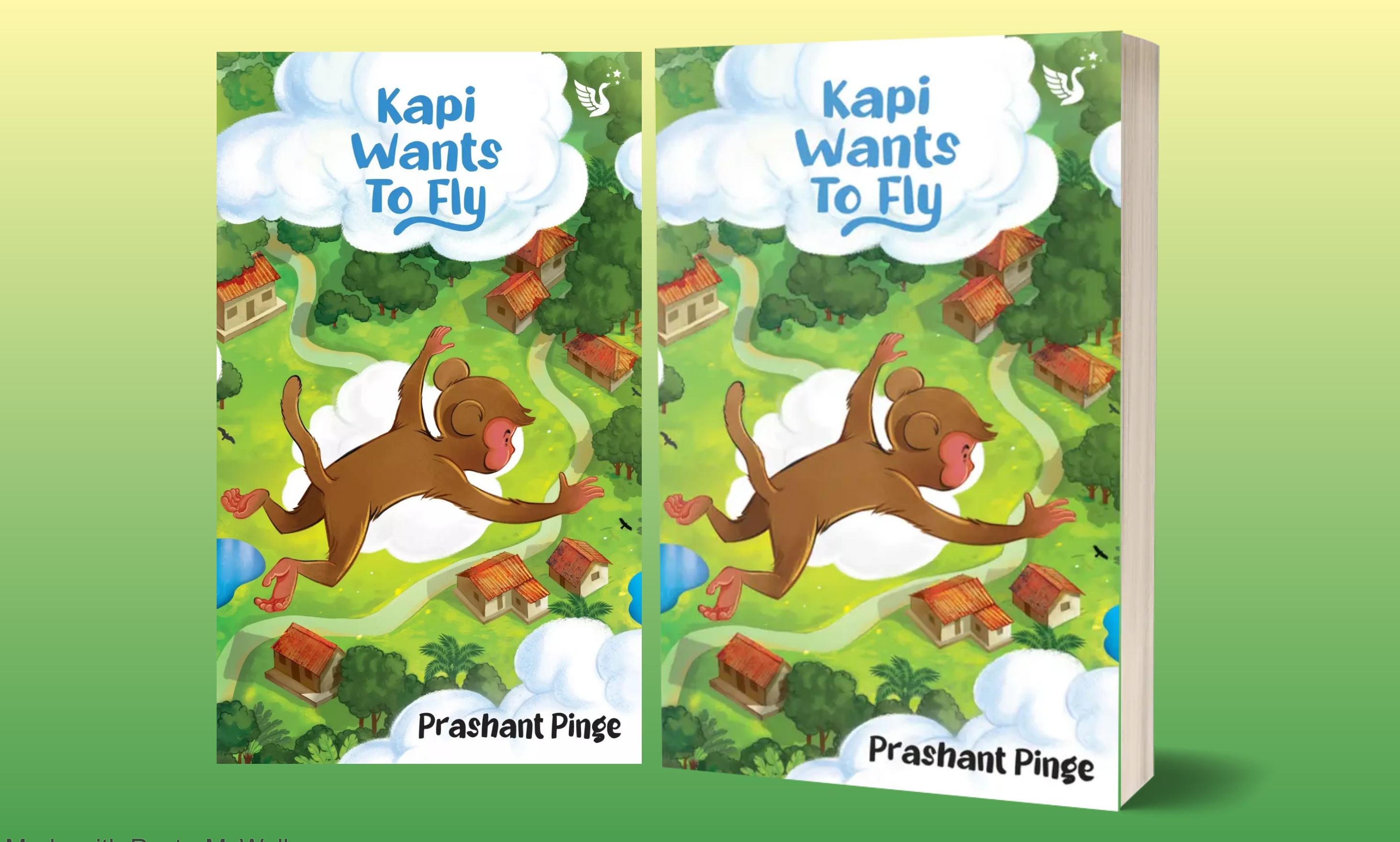Prashant Pinge loves stringing words together to create enchanting stories for children. He also utterly disregards reality. Little wonder then that he prefers residing in sixteenth-century England next to the Bard’s house, where he spends his days in the company of his characters and nights taming wild dragons.
 Readomania: Tell us something about yourself. How did you start writing?
Readomania: Tell us something about yourself. How did you start writing?
Prashant: I grew up in the picturesque neighbourhood of Shivaji Park in Mumbai. I found myself immersed in story books from a very early age which sparked my imagination and creativity. While I was a diligent student, I also indulged in various other activities, including drawing and playing racket sports. I have travelled and lived in several countries but am now settled in Pune and prefer spending my time pursuing my passions.
My journey into writing began after experiencing a particularly vivid dream about two decades ago. Inspired by this dream, I decided to put the proverbial pen to paper. Since then, I've been dedicated to crafting stories, primarily in the realm of children's fiction. While I find immense joy in creating enchanting tales for young readers, my interests also extend to romantic comedies. In the future, I aspire to delve into historical fiction as well.
As such, writing has become a constant companion on my life's journey, allowing me to explore the boundless realms of imagination and share my stories with the world.
Readomania: You love creating enchanting stories for children. What is it that you love about writing for children?
Prashant: Writing for children allows me to let my imagination take flight. The freedom to explore fantastical ideas, quirky characters, and whimsical settings is incredibly fun. It's a journey where creativity knows no limits, and the joy of crafting stories for children is an adventure that I eagerly embrace with each new tale.
What I also love about writing for children is the endearing way they immerse themselves in stories, experiencing them with a sense of wonder and curiosity that is truly enchanting. The sparkle in their eyes as they explore these imaginative worlds is a constant inspiration that fuels my passion for storytelling.
Finally, I cherish the fact that children's books are often accompanied by illustrations. This visual element adds an extra layer of magic, bringing the stories to life in a way that is both captivating and memorable.
Readomania: What are the most important aspects of writing children’s books? Any tips for aspiring authors?
Prashant: When it comes to writing children's books, several key aspects contribute to creating captivating and memorable stories. First and foremost, it's crucial to craft engaging plots that capture the attention of young readers. These plots should be filled with excitement, curiosity, and a touch of magic to keep children eagerly turning the pages.
Another essential aspect is the creation of relatable characters. When characters resonate with the experiences, emotions, and curiosity of children, it strengthens the bond with readers. Children ask the most amazing questions, and as an author, it's important to be ready to answer and spark their inquisitive minds.
Lastly, keeping the storytelling simple is fundamental for aspiring authors. To truly connect with young readers, it's important to channel your inner child, understand their perspective, and use language that is easy for them to comprehend. The goal is to immerse children in the story, making the reading experience enjoyable and meaningful.

Illustration by Ajit Narayan, Kapi Wants to Fly
Readomania: How did you envision the character of Kapi, the little monkey who wants to fly?
Prashant: The inspiration for Kapi, the little monkey who dreams of flying, struck me during a visit to a resort in Mahabaleshwar. The resort boasted a lush tree cover inhabited by a lively troop of monkeys, living happily in their own world amidst the branches.
As I pondered the monkeys' lives, a compelling "what if" question emerged in my mind: What if there was a monkey among them who didn't find joy in jumping but harboured an earnest desire to soar through the skies? This imaginative scenario became the seed for Kapi's character, the starting point for the plot of the story.
I have envisioned Kapi as a small monkey with a big heart and unwavering courage. Despite his diminutive size, he embodies the spirit of determination, choosing to pursue his dreams and confront challenges head-on, even in the face of danger. I hope he encourages young readers to embrace their uniqueness and pursue their aspirations with courage and conviction.
Readomania: You were very specific about the look of each character in the book. Your accurate description made the job of our sketch artist much easier. Do you draw mental sketches before etching your characters?
Prashant: I place great importance on vividly visualizing each character before delving into their descriptions. This mental sketching process is not just a personal preference but a crucial step in the creative journey. When writing, especially for a children's book where the reader's imagination is paramount, the ability to convey distinct characters is vital.
Having a clear mental image of each character, especially the main ones, significantly enhances the narrative. It's not only about their appearance but also about capturing their unique mannerisms, the way they speak, and the essence of their personalities. This attention to detail ensures that when I describe them in the narrative, the words paint a vivid picture for the reader, allowing them to connect with and visualize the characters on a deeper level.
Furthermore, this detailed mental sketching not only enriches my writing process but also serves as a valuable guide for the artist. By describing my characters in detail, it helps the artist bring them to life in the illustrations, maintaining the authenticity and charm I want to convey through the written words.
Readomania: The friendship between Kapi, Vajra and Tara goes through some upheavals but is rock solid at the end. Can we expect more adventures from the trio in the future?
Prashant: I particularly enjoy writing about the dynamics of friendship, as it allows me to explore how characters evolve, much like we all do in real life. While friendships, like life, may encounter ups and downs, I strive to imbue my stories with a sense of positivity amidst the twists and turns of the plot, ultimately leading to happily ever afters.
As of now, I haven't planned another adventure for the trio, but I'm always open to the possibility of taking them on new escapades if a compelling and interesting idea presents itself.
Readomania: What do you think are the main differences between writing for children and writing for adults?
Prashant: Writing for children and adults presents distinct challenges and opportunities. While writing for adults requires strong plots without any loose threads, crafting stories for young readers is a task that demands a delicate balance of clarity and simplicity along with a touch of whimsy.
One of the key differences when writing for children is the freedom to be more imaginative. In my opinion, children tend to readily immerse themselves in the fantastical, embracing the extraordinary with open hearts. In contrast, adults tend to be more cynical, approaching fiction with a more critical lens.
However, while children’s writing may take on simpler hues, it must also be engaging. Moreover, the dynamic nature of children’s curiosity adds an intriguing element to the writing process, especially concerning the questions they pose. The author needs to address their inquisitiveness with creative and satisfying answers.
Conversely, writing for adults often involves adhering to logical narratives. Grown-up readers typically appreciate stories that follow a clear and coherent logic, even within the domain of fantastical stories. They prefer characters etched in detail and plot-driven stories that offer an engaging and interesting experience without disrupting the flow.
In essence, it's crucial for writers to understand their audiences and use their creativity to meet the preferences of each age group.

Illustration by Ajit Narayan, Kapi Wants to Fly
Readomania: What were your favourite books while growing up? And as an adult, what is your favourite genre?
Prashant: Growing up, I loved reading Enid Blyton's enchanting tales. The vivid imagination and magical adventures portrayed in her books fascinated me, and I often found myself yearning to embark on similar fantastical journeys.
As an adult, my literary preferences have evolved, and I find myself exploring diverse genres. I do have a favorite author, though – the inimitable P. G. Wodehouse. I thoroughly enjoy his humorous works, finding them not only amusing and captivating but also enriched by his mastery of language, which infuses a unique flavor into the tales.
Readomania: The lure of the digital screen is too much for kids these days and as a result not many have the inclination or attention span to read books. How do you think parents can encourage children to develop the healthy habit of reading?
Prashant: In today’s digital age, fostering a love for reading in children requires a multi-faceted and creative approach. Parents play a pivotal role in shaping their children's reading habits, and adapting to the digital landscape is a key consideration.
While digital is everywhere, parents can be creative in ensuring that children engage with books. Embracing digital books can be one approach, introducing children to the world of e-books and audiobooks. However, it's equally important to cultivate an appreciation for physical books. The tactile experience of holding a book, turning its pages, and relishing its distinct smell is a great way to foster a deeper connection with reading.
Parents, as role models, should also set the tone by creating a warm and inviting reading environment at home. If children witness their parents enjoying books and making reading a priority, they are more likely to follow suit. Parents should encourage children to view reading as a pleasurable activity rather than a chore. Additionally, making reading a shared activity will not only strengthen the parent-child bond but also instill a sense of joy and wonder associated with books.
Readomania: What are you writing next? Will it be fiction for kids or adults?
Prashant: I'm currently immersed in writing a romantic comedy filled with amusing twists and turns, infused with a healthy dose of Wodehousian humour. The intricacies of the plot and the focus on delivering humor through the writing style have made this project particularly enjoyable for me.
Simultaneously, I'm in the early stages of developing the plot for a children's book. It's a delightful process, as I thoroughly enjoy fleshing out the characters and crafting the storyline. I'm eagerly looking forward to diving into the world of children's fiction once again after wrapping up my current romantic comedy.
Balancing the creative process for both grown-ups and kids makes my writing adventure more interesting and diverse. I can't wait to share these new projects with my readers!
Readomania: Thank you for the lovely conversation Prashant
His book is available on Amazon, please click on the link below to buy it.


Comments